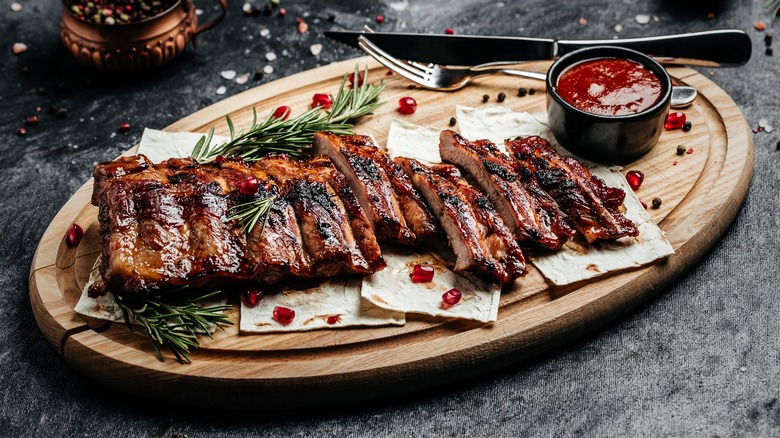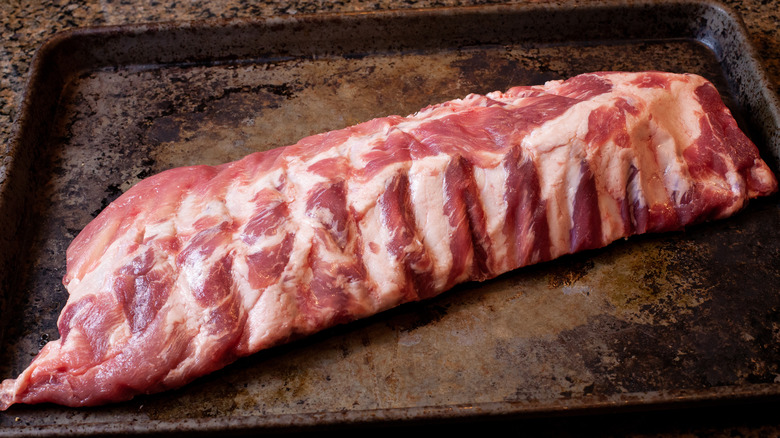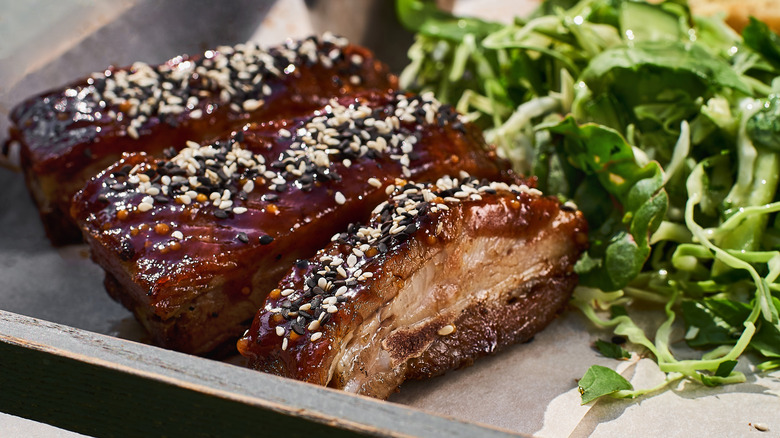Baby Back Vs. Spare Ribs: What's The Difference?
From sticky ribs at the local Dim Sum to all of the regional styles of barbecued ribs, the popularity of this dish is undisputed. Almost everyone can agree that pork ribs are as fun to gnaw on as they are delicious. According to Statista, when it comes to fresh pork, only chops outsell ribs. Everything else is a distant third.
But "ribs" is a vague term as they can be divided into a handful of different cuts (per BarbecueFAQ). Ribs run from the spine around the pig down to the belly. Next to the spine, on the back of the pig, the ribs are covered with pork loin. Underneath the loin are baby back ribs. As you move toward the belly, ribs beneath what will eventually become bacon are called spare ribs. Spare ribs can be left whole. Or they can be trimmed into a squared-off rack called St. Louis ribs. The trim left behind becomes rib tips.
Country-style ribs confuse matters as they come from the pork loin. This cut can be divided into a portion that has a side with four ribs and a boneless side. Country-style ribs don't have the classic look of a long, curving bone. For that, you'll need baby back or spare ribs. But, is one of them better than the other?
The meaty difference
BarbecueFAQ explains that "baby back" is a good name as it identifies the location and differentiates them from the larger spare ribs. Contrary to what some may believe, they aren't from baby pigs. These ribs are a neat and rectangular slab of ten to thirteen bones. The meat on baby backs is from the loin — meaning they're lean and tender. Those attributes make for a popular style of ribs. That and a catchy song from a massive Chili's ad campaign. Interestingly, the songwriter responsible for the baby back rib anthem hasn't even tried them. At least not from Chili's.
Spare ribs are a larger, more irregular rack of fatty meat that's left behind after the bacon is removed. Spare ribs connect to the sternum, which is full of cartilage and collagen. While not as lean as back ribs, those bits of connective tissue will, with enough time, melt into gelatin-rich meat that's juicy and will really stick to your own ribs.
For a tidier rack of spare ribs, St. Louis-style ribs are the answer. To get these to a rectangular rack, the ends of the ribs that connect to the sternum are removed. Because these are the middle of the ribs, they can sometimes be labeled as "center cut."
Which is the rib for you?
The difference really comes down to how you enjoy your meat. Spare ribs are fatty and juicy with some chew, while baby back ribs are the fall-off-the-bone, tender type.
Bon Appétit notes that for either type of rib, look for ones that have plenty of meat covering the convex side of the rib. When butchers remove the loin or bacon, they can leave behind different thicknesses of meat on the ribs. Look for at least ¼ inch of meat that's evenly distributed across the rack. The fat should be distributed evenly throughout the meat in thin streaks. That's called marbling and will result in juicy, flavorful bites. In some cases, the fat is isolated into pockets that won't cook as evenly or provide the self-basting of good marbling.
Barbecue is the classic cooking technique and each style of rib is well suited for the smoker. Because baby back ribs are relatively lean, they will cook faster than spare ribs which need more time to become tender. That rule of thumb is true whether you braise some Sticky Spare Ribs, grill some Herb-Rubbed Baby Back Ribs, or toss your rack into a slow cooker for Slow Cooked Spare Ribs and Idaho Potatoes. Don't let barbecue fanatics fool you, there are all sorts of ways to achieve tasty ribs.


